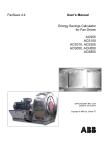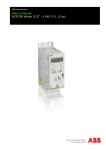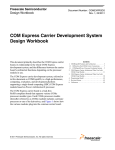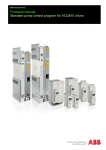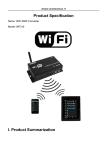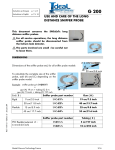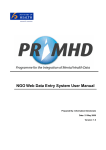Download PumpSave 4.4 User`s Manual Energy Savings Calculator for Pump
Transcript
PumpSave 4.4 User’s Manual Energy Savings Calculator for Pump Drives ACS55 ACS150 ACS310, ACS355 ACS550, ACH550 ACS800, ACQ810 3AFE 64191691 REV J EN Effective: 24.03.2010 Copyright © ABB Oy, Drives/TT 1 — General PumpSave is a calculation tool running on Microsoft Excel to calcultate the energy savings available when using a variable speed AC drives (ABB frequency converter) compared to other pump control systems. Comparisons are made with throttling control, ON/OFF control and adjustable speed control using a hydraulic or other type of slipping drive. Calculations are based on typical centrifugal pump operating characteristics and some other assumptions. Consequently, the accuracy of the results is limited. The accuracy of the results is also affected by the accuracy of the input data. Results should be used only for estimating purposes. The results of this program must not be used as the basis for guaranteed energy savings. Results of calculations can be printed out. When more accurate computing is needed the DrivePump1.2 PC SW from ABB Drives is recommended. Version 4.4 First multi language revision. ACS355 added. Version 4.3 Added possibility to translate the PumpSave to languages. Version 4.2 The tables of ABB Drives have been updated for ACS550, ACH550 and new drives added AC310, ACQ810 and minor changes done for look and feel. Version 4.1 The tables of ABB Drives have been updated and user manual corrected to the level of current PumpSave. PumpSave 4.0 did not have a valid user manual. Most data fields are populated with default values to help users. Version 3.11 Version 3.11 fixes a bug that affected energy calculations in the previous version. The calculation for ON-OFF control energy usage ignored motor efficiency given by the user, assuming 100% motor efficiency. This omission has now been corrected. 2 2 — Starting and Running the Program Software Required Microsoft® Excel 97 or later is required to run the energy calculation workbook. With Microsoft® Office Excel 2007 the workbook runs on compatibility mode. Also you shall enable the running of macros. Files Provided The PumpSave files for pump drive calculations are incorporated into Excel workbook named originally PumpSave44.xls. Installation No installation is required but the workbook is can be copied to a hard disk and short-cut arranged to desktop. Opening the Workbook Start Excel as usual. For pump calculations open PumpSave44.xls. Sometimes it will open in Full Screen mode. Hence, the usual Excel toolbars are not visible. Full Screen mode can be disabled and enabled by selecting Full Screen from the View menu. With Excel 2007 the hitting the Ecs will open the ribbon. As PumpSave is opened, a welcome window is displayed. Figure 1 shows the welcome window for PumpSave. The welcome sheet presents three comparative calculation options. Click Continue to close the window. Figure 1 Welcoming window of PumpSave Then also a long license agreement text is shown. 3 Worksheet After having clicked Continue button and accepting the license terms, the worksheet will open, see Figure 2, where input data is entered and results are presented. The language setting is on top right corner. The translated words and help texts are taken from Language sheet based on English keywords. This manual explains the English ones. There are four buttons in the center of the sheet, Auto-Adjust screen size screen button, Send to default printer button, Save calculation button and Close program button. PumpSave is optimized for desktop area of 1600*1200 pixels. If the PumpSave view is not fully visible, click the Auto-Adjust screen size button. This zooms 4 the screen so that it should fit into the visible area. It is also possible to zoom the sheet by selecting View – Zoom from Excel menu bar. To exit the program, click the Close program button, or, click the cross button in the upper right corner of the screen. Then Excel will prompt to save the workbook. Also you can save a copy of worksheet to a hard disk by selecting File- Save as from Excel menu bar and save the calculations and give it a different name. Click the Send to default printer button. The sheet can also be printed by selecting File and Print from the Excel menus. 5 3 — PumpSave worksheet inputs and results General All white cells on the calculation sheet are for entering information and data. Please use for decimal symbol either comma or decimal point etc according you Excel settings. The sheet is filled in by default values to help users to right away find the idea of worksheet. Results are displayed on pale yellow background. Figure 2 shows a default calculation sheet. Figure 2 PumpSave view Input data The required data includes system data, pump data, existing flow control method, motor and supply voltage data and operating profile. Economic data such as energy price and investment cost is required in order to get figures for investment appraisal. System data Liquid density, (kg/m 3 ) Enter the density of the liquid at the pump inlet in kilograms per cubic meter. The density of water is 1000 kg/m 3 at 20 C. 6 Hmax PUMP system curve, Hsi=Hst+(Q i/Q n) 2.(H n-Hst) HN pump curve, Hpi =Hmax-(Qi/Q n)2 .(H max-Hn) SYSTEM Hst QN Graph.1. Typical pump and system curves. Static head, Hst (m) The static head is the difference between the static pressure at the pump discharge and the static pressure at the pump inlet but converted to head. It is the net distance that the pumped fluid is lifted, but additionally the pressure (liquid and gas) in the container has to be taken into account while determining the static head. Pump data Nominal volume flow, Q n (m3 /h) Enter the maximum system flow in cubic meters per hour, which the existing system will deliver and the pump must reach with existing control. PumpSave will assume that exactly the same flow has to be delivered also with AC drive. The energy saving calculation is based on flow rates that are equal to or less than Qn. The entered value is also shown in liters per second. (1 l/s = 3.6 m 3/h) Nominal head Hn (m) Enter the head in meters that must be generated by the pump to produce the given nominal volume flow Qn considering the system curve. The value must be determined from the pump curve and system curve intersection. One assumption which PumpSave makes is that the system curve with existing control and AC Drive control are the same. In reality this is seldom the case. In DrivePump SW the two are separate values. Maximum head Hmax (m) Enter the discharge head pressure that will be developed by the pump at full speed and zero flow. The value must be determined from the pump curve. If the pump curves look complicated select a Hmax which together with Hn define a nice second order curve in the range 20….100% Qn. Efficiency, p (%) Enter the efficiency of the pump at volume flow Qn . The efficiency value should be given with the impeller which will be used. 7 Existing control method Existing Control Method Pick the existing control method that you want to compare with ABB AC Drive control. The control method is selected from the drop-down list on the upper left part of the sheet. The options are throttling, on/off control, and hydraulic control. The smaller energy usage of frequency converter is compared to a large energy required by: • Throttling which means the liquid flow control is made by throttling valve and motor and pump is running at full speed and pressure. • ON/OFF which means ON/OFF duty is adjusted according to flow requirements and a reservoir is available. The control can’t be as good as with speed control. When pump and motor is running they run at full speed. • Hydraulic which is based on hydraulic drive or some other type of slipping drive such as an eddy current magnetic coupling drive. The motor is running with full speed but with slip the pump shaft is controlled. Motor Data PumpSave is computing from pump data the required motor output power including 10% thermal margin. Based on this number you may enter the Motor power. Motor power (kW) Enter the nameplate power rating of the motor. This is used to select the proper drive rating. The program uses calculated power demand to determine energy savings. Supply voltage (V) Enter the supply voltage used in application. The value should be between 115 (1-ph) to 690 V (3-ph). This is used to screen out some drive types. Motor efficiency, m (%) Enter the motor efficiency from the motor nameplate or from other data supplied by the motor manufacturer. Use the efficiency for full load operation on fixed frequency utility power. The program will adjust the efficiency for operation at reduced speeds and loads. If the motor is oversized for the application, enter the efficiency for operation at the maximum applied load. 8 Operating profile Annual running time In other words, this is the total operating time per year (h). Enter the estimated number of hours that the pump is expected to run during a year’s time. For 24 hour, 365-day operation, enter 8760 hours. Operating Time at Different Flow Rates (%) Enter the estimated time as a percentage of the total operating time for operation at each of the listed flow rates from 100% to 20% of nominal volume flow. Leave blank or enter zero for flow rates that are not used. The sum of the entered percentages should be 100%. A figure under the white cells shows if the sum equals 100. If it does not, a comment “THIS SUM MUST EQUAL 100!” shows. Economic Data Currency Specify here the currency to be used in calculations. The default unit is the Euro (EUR). Energy price (per kWh) Enter the price of energy per kilowatt-hour (kWh). The PumpSave program does not have provisions for calculating demand charges. To estimate energy cost including demand charges, enter the average cost of energy per kWh including average demand charges. Investment cost Enter the estimated additional cost of purchasing and installing a variable speed AC drive as compared to the alternative method of flow control used in the comparison. Use the same currency units as entered for energy cost. This entry will be used to calculate the direct payback time. Interest rate (%) This is the compensation for capital in the net present value calculation. Service Life (years) The expected service life of the drive. Also this is required for the net present value calculation. Results The results of the calculations include the estimated annual energy consumption for the existing control method and for AC drive control, the difference of these two, which equals the annual energy saving achieved by using a variable speed AC drive. PumpSave also estimates the reduction in carbon dioxide (CO2) emissions due to the reduced electricity consumption. CO2 is the most important of the greenhouse gases, which cause a global environmental problem called the climate change. Payback period is calculated for the investment in the drive as compared to the alternative method of flow control. Net present value is also calculated provided that the user enters an interest rate and service life. 9 Energy & environmental Energy Consumed – graph (kWh) The calculated energy used annually with the existing control method and using a frequency converter for flow control are both illustrated in two-column chart. Saving percentage % The reduction in electricity costs in percents. This is also, of course, the energy saving in percents. Annual energy consumption (kWh) These are shown for both with existing control method and improved control method. Annual energy saving (kWh) This is the energy difference in favor of frequency converter control. Annual CO2 reduction (kg) The reduction in carbon dioxide (CO2 ), which results from the reduced energy consumption due to variable speed control. Carbon dioxide CO 2 is the primary greenhouse gas causing global warming. The CO2 reduction depends on the CO 2 emission per unit, which should reflect the way and emissions the electricity used has been generated with. The per unit emission is given in kg/kWh consumed, and it can be altered by the user. Economic results Annual money saving This is how much money you save thanks to the variable speed control by AC drive. Money saving comes in the form of smaller electricity bill. Payback period This direct payback time shows how many years the investment has paid itself back. Net present value Net present value (NPV) is a more advanced method for analyzing investments than the payback period rule. If the NPV is positive, then the investment should be accepted. 10 4 — PumpSave calculations with US Units Input Data with US Units The initial data presented in the following consists of the same elements as above but is entered using US measurement units. The following applies when “US Units” is selected. In the following the changes to non-SI are only explained. Figure 3 PumpSave view with US units Pump data Nominal volume flow, Q n (gpm) Nominal head Hn (ft) Maximum head Hmax (ft) System data Liquid density, (lb/ft³) Enter the density of the liquid at the pump inlet in pounds per cubic feet. The density of water is 62.4 lb/ft³ (default value). 11 Static head (ft) Motor Data Nominal Power, (Hp) Drive Data Nominal Efficiency, m (%) Based on motor power and voltage, PumpSave suggests appropriate drive type to be used. It is shown on the right side of the “Drive Data” box. If the motor voltage is between 200 and 690 V, PumpSave recommends a low voltage AC drive type available in the US markets. 12 5 — Explanation of Calculations In this chapter, the formulas behind PumpSave calculations are presented. The formulas use metric units. If the user enters the data in US units, PumpSave converts it to metric units first. The conversion factors are given in the end of this manual. Pump operating point The formula for the pump curve estimate used in calculations is: 2 H pi H max Qi H max H n Q n This might be somewhat erroneous to submersible and high characteristic speed pumps etc. Respectively, the system curve used in calculations is 2 Qi H si H st H n H st Q n A pump will always operate where these curves intersect, as Graph 1 shows. Please notice that the point defined by Hn and Qn is assumed to be known and valid for pump and system curve. Hmax PUMP system curve, Hsi=Hst+(Q i/Q n) 2.(H n-Hst) HN pump curve, Hpi =Hmax-(Qi/Q n)2 .(H max-Hn) Hdyn SYSTEM Hst QN Graph.1. Typical pump and system curves. When adjusting the pump speed to control the volume flow, the process moves via system curve Hsi. Respectively, when throttling the pipeline the pump operates continuously at the same speed, and the movement of the process is via pump curve Hpi. Pump drive calculations The nominal shaft power of a pump is calculated from the formula 13 Qn Hn 0.981 P p In the calculation sheets, calculations are at single points for Q = 20% to 100% of nominal pump flow Qn. Q is the actual flow. H is the total dynamic head at flow Q. The efficiency figures are multiplied with k-factors witch take into account operating conditions with some accuracy. These correcting factors are defined based on experience. Efficiency 100 % vsd m DRIVE 95 % p MOTOR 80 % PUMP Graph 2. Typical efficiencies. Flow This gives the following formulas for power calculations: Frequency converter control Qi Hsi 9.81 , where p m kmi kvsdi *vsd Pvsdi kmi Qi Qn kvsdi table 0 .2 0 .2 Hst Hn Throttling control, assuming constant motor efficiency Qi Hpi 9.81 Pthi , where p kpi m kpi Qi 2.4 1.44 Qi Qn Qn ON/OFF control, assuming constant motor and pump efficiency Qi Hn 9.81 PON OFF _ avg p m 14 Hydraulic control, Qi Hsi 9.81 Phyi , where p m nhi nhi 0.98 Qi 1 Qi 0.75 Hst Hn 0. 5 The rated efficiency of hydraulic coupling is assumed to be 98%. The required power for the compared control method is calculated and the energy consumption per year is thereafter calculated from the formula E Tki Pi Unit Conversions The formulas above use metric measurement units. In the case US units have been selected to be used in entering the data and presenting the results, the following conversion factors have been used: Nominal volume flow Head Liquid Density Nominal Power Mass (weight) Qn: H: D: P: m: [gpm]* 0.22712471=[m³/h] [ft]* 0.3048 =[m] [lb/ft³]* 0.016018463=[kg/dm³] [Hp]* 0.7457=[kW] [lb]*0.4536=[kg] 15















